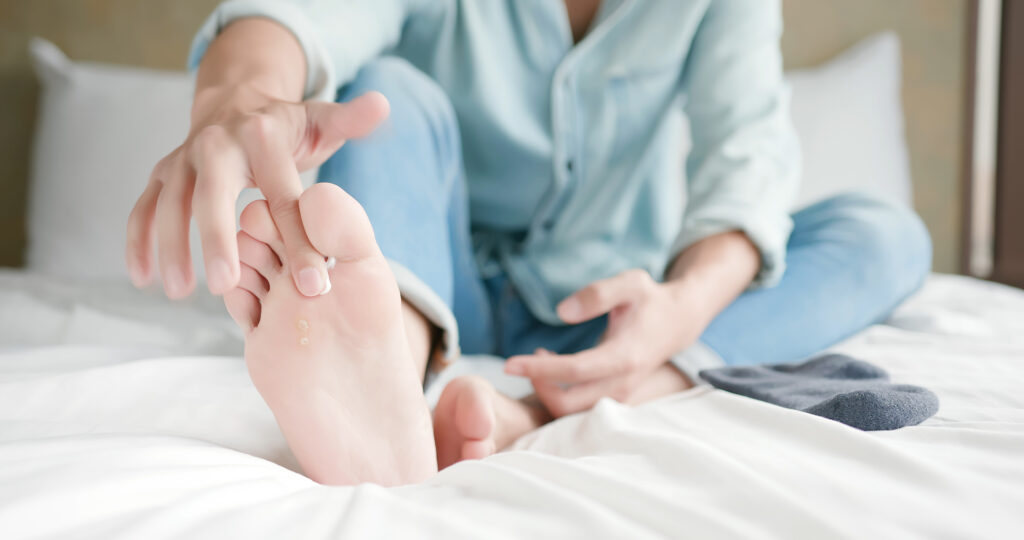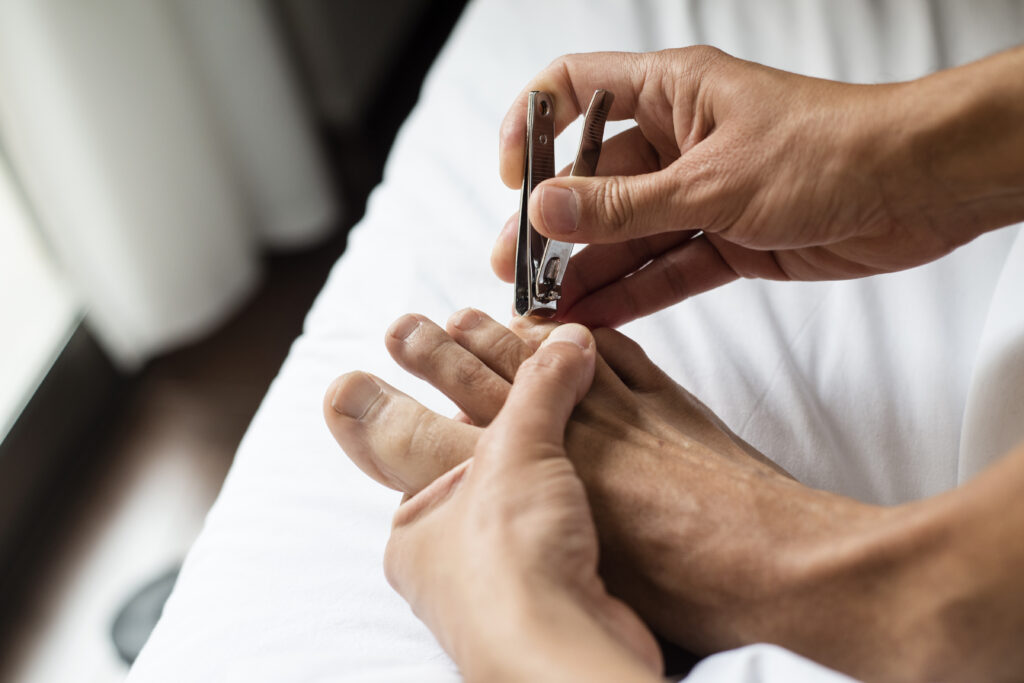Foot Fungus
Foot fungus is a skin infection where fungus germs grow in your skin cells, causing symptoms like peeling, cracking, itching, and blistering. It is unsightly and may cause pain in the sufferer.
While foot fungus isn’t usually anything to worry over, you should treat it as soon as possible to minimise discomfort and prevent passing it on to others – especially if you partake in sports like swimming and gymnastics.
If you think you may have foot fungus or are keen to know the signs for quick treatment action, this guide has it all.
Keep reading to discover:
- Why Foot Fungus is so common
- The two common forms of foot fungus
- What to expect from foot fungus
- Tinea pedis (athlete’s foot): symptoms, causes, treatment & more
- Onychomycosis (nail fungus): symptoms, causes, treatment & more
- Home remedies for foot fungus
- Foot fungus protection: 5 tips
- When to see a doctor
- FAQs
Why is Foot Fungus so common?
Foot fungus is so common because fungus thrives in dark, damp, warm areas like shoes. When you sweat from your feet all day, you create a warm, moist environment where fungus can thrive. There is a common misconception, however, that all fungus is bad.
That isn’t true. In fact, there are over 80 types of fungi on every single person’s feet – fungus that doesn’t cause problems. It’s just certain types of fungus that cause infection leading to unpleasant symptoms in the sufferer.

What are the two most common forms of Foot Fungus?
Below are the two most common types of foot fungus.
1. Tinea Pedis
Tinea Pedis (often known as athlete’s foot) is the most common type of foot fungus infection, affecting around 1 in 10 people at any given time. It is caused by the dermatophyte fungi, often targeting the toes and creating itchy, flaky skin. It can, however, spread to the soles, sides, and heel of the foot. Treatment involves an anti-fungal cream like the Pevaryl 1% Topical Cream.
2. Onychomycosis
Another type of foot fungus is onychomycosis, which is also known as nail fungus. As you would expect, it’s a type of fungus that affects the nails. It can make nails thick, brittle, and discoloured, as well as cause the sufferer pain.
What to Expect from Foot Fungus
Below you can find more information about these two types of foot fungus infections, including their symptoms, causes, and treatment options.
Tinea Pedis (Athlete’s Foot): Symptoms, Causes, Treatment & More
Symptoms:
Athlete’s foot often occurs between the toes, causing itching, burning, peeling, and scaly skin. It can also spread to other areas of the foot. Here are the most common symptoms:
- Dry, scaly skin between the toes
- Redness and inflammation
- Itching
- Burning
- Blisters
- Peeling
Causes:
Fungi thrive in warm, damp areas like socks. It can be caused by living in humid conditions, wearing shoes too often, and sweating a lot. Athlete’s foot can also be passed on from person to person. If you share a towel or walk barefoot where another person with athlete’s foot has walked, you may get the infection.
That is why swimmers are more at risk of athlete’s foot than others – they walk in warm, wet environments without foot protection.
Diagnosis:
Athlete’s foot is usually easy to spot, so you can treat it at home. If you go to the doctor, they will take a look at your feet and potentially take a skin sample to properly diagnose the athlete’s foot.
Treatment:
Foot fungus treatment often comes in the form of anti-fungal cream. You can either get it over the counter or as a prescription from your doctor. Pevaryl 1% Topical Cream is effective, targeting the type of fungi causing the infection. Use this once a day for fourteen days to clear up your athlete’s foot. It’s important to cover the entire infected area when applying the anti-fungal cream.
Potential Risks:
While athlete’s foot does not pose too much risk and clears up quickly with an anti-fungal treatment like Pevaryl, there are some risks if it goes untreated. Athlete’s foot can spread to other parts of the body – in particular, your palms and groin area.
There is also a risk of a bacterial infection getting in through the cracks in your skin caused by the athlete’s foot.
If you experience prolonged athlete’s foot that doesn’t seem to get better with topical treatments, see your doctor.
Onychomycosis (Nail Fungus): Symptoms, Causes, Treatment & More
Symptoms:
Nail fungus affects the nails – more commonly toenails. It often changes the appearance of the nail, causing discolouration, thickness, and even slight distortion of the nail. Here are the most common symptoms of onychomycosis:
- Thick nails
- Brittle, crumbly nails
- Discolouration of the nails (often yellow)
- An unpleasant odour
- Distortion of nail shape
Causes:
Onychomycosis is caused by a type of fungi that affects the nails and can be spread from athlete’s foot. You may also get nail fungus if you sweat a lot, live in a hot climate, or wear shoes and socks for prolonged periods.
Some people are more at risk of nail fungus, too. If you have poor circulation, a skin condition like psoriasis, or you are older, you are more at risk of getting nail fungus.
Diagnosis:
If you’re not sure if what you have is nail fungus, you should go to the doctor. There, they will examine the foot and nail, ask questions, and maybe take a nail clipping to go to the lab. You will then receive a confirmation on whether or not you are dealing with nail fungus.
Treatment:
Treatment for nail fungus includes anti-fungal nail polish, anti-fungal oral medications, and anti-fungal nail cream. You can pick these up over the counter, but your doctor can also prescribe them to you.
In serious cases, some people have to get surgery on the nail itself. Surgery usually only occurs when the nail fungus has been around for a long time and is not responding to treatment. It involves removing the nail – either permanently or temporarily. If it gets temporarily removed, the surgeon removes all fungi underneath the nail before putting it back on.
Risk Factors:
If left untreated for too long, nail fungus can cause permanent damage to your nails, causing them to look thick, discoloured, or distorted for life. It can also spread to other areas. You are also more at risk of getting a bacterial infection while you have nail fungus.
Home Remedies for Foot Fungus
While it is recommended that you use an anti-fungal treatment like Pevaryl or anti-fungal nail polish to clear up your foot fungus, some people have success with home remedies such as:
- Rubbing Alcohol
- Talc
- Tea Tree Oil
- Apple Cider Vinegar
The rubbing alcohol, tea tree oil, and apple cider vinegar are used to kill the living fungus on your foot. The talc dries the area, stopping the fungus from spreading.
Foot Fungus Protection: 5 Tips
Stopping foot fungus from occurring or spreading is all about avoiding the ideal environment it grows in. Follow these 5 prevention tips to avoid getting foot fungus:
1. Wash and Dry Feet Daily
It is much easier for fungi to grow in warm, wet environments. If you have been walking around all day in socks and enclosed shoes, fungus has a chance to grow. That’s why it is so important to wash and dry your feet thoroughly every day.
It’s especially crucial to ensure that your feet are completely dry before putting socks back on. Otherwise, you trap in moisture and heat, creating the perfect environment for fungi.
2. Take Off Your Shoes and Socks
One of the best ways to prevent foot fungus is to take off your shoes and socks whenever possible. Give your feet some breathing room by removing your shoes and socks as soon as you get home from work – especially if your job requires a lot of standing around.
3. Protect Your Feet While in Public
Foot fungus is contagious. If you ever walk around with bare feet, you are at risk of picking up a fungal infection. That’s why you must protect your feet where possible. If you are a swimmer, for example, you could wear swim socks. If you’re walking around a pool on holiday, wear flip-flops.
4. Use Foot Powder
Fungus loves moist environments. There are 250,000 sweat glands in your feet alone, making it the perfect place for fungus to thrive.
Stop that in its tracks by using a foot powder each day. It is especially helpful if you live in a humid environment or your lifestyle requires you to stay in shoes and socks for long periods.
5. Keep Your Nails Clipped
To prevent nail fungus, keep your nails neat and clipped. It is best to cut them straight across. Remember – do not share nail scissors, as you may pick up a fungal infection from another person this way.

When to See a Doctor
Foot fungus infections can usually be treated at home with a foot fungus cream like Pevaryl 1% Topical Cream. If that isn’t working, it’s time to schedule an appointment with your doctor.
You should also see your doctor with a foot fungus infection if you have diabetes or encounter swelling or a fever.
Frequently asked questions
Is Athlete’s Foot Contagious?
Yes – athlete’s foot fungus is contagious and can easily be spread to others. That’s why you must protect your feet and avoid sharing towels.
What Does Foot Fungus Look Like?
The look of your foot fungus depends on which type you have. For instance, athlete’s foot looks like scaly, red, flaky skin, usually around the toes. It can spread to other areas of the foot, like the sole and the heel. Nail fungus may show discoloured and slightly misshapen nails.
How do you know if your foot has fungus?
You should be able to tell whether your foot has fungus by the several symptoms associated with it. If you have athlete’s foot, you may have dry, scaly skin between your toes, red and irritated skin that itches, burns, blisters or peels. If you have nail fungus, you may notice thick nails or brittle, crumbly nails. Often, these will be discoloured and have an unpleasant odour. You may even notice the shape changes. These symptoms are all signs that you may have a foot fungus.
How Did I Get Foot Fungus?
Foot fungus often occurs in two ways: by picking it up from someone else or by creating the perfect environment for it to grow in. You might wear your shoes too often without giving your feet a break, or perhaps you picked it up in a public space.
How do I get Rid of Fungus on my Feet?
Foot fungus is easily treated with anti-fungal creams, like Pevaryl 1% Topical Cream, and medications.
No products found